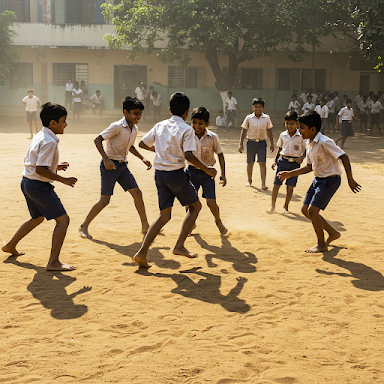From 6th to 10th standard, Don Bosco School in Perambur was more than just a school—it was my universe. The hours between 9 and 3:30 were ruled by textbooks and blackboards, but from 12:30 to 1:30, I was truly alive. Lunch break. That hour was sacred.
As soon as the bell rang at 12:30 PM, tiffin boxes would fly open the moment we found our usual spots—under the trees, lounging in the corridors, or lined up on the steps of the assembly stadium. The smell of home hit you first: soft idlis with millagai podi, chapatis rolled with spicy egg burji, curd rice with mango pickles, lemon rice, tomato rice glowing bright, crispy potato fry, or a handful of plantain chips.
But if you forgot your lunch—or just craved something extra—you knew exactly where to go: the school canteen. It was a humble setup, but it had everything that mattered.
Butter biscuits, golden brown samosas with an onion filling, and piping hot tea and coffee in steel tumblers that made you feel very grown up. But the best of them all? Iced buttermilk.
Cold, salty, slightly sour, and refreshing beyond words—it tasted like salvation after a round of chappal cricket.
Ah yes—chappal cricket.
One slipper became a bat. Three lines on a wall were all we needed for stumps. Our rules were simple, strict, and totally made up:
Runs only if you hit to the right side.
One-pitch catch? Out. No arguments.
And then there was the dreaded mudhuku puncture.
Now that was a game. Whoever had the rubber ball in hand was the hunter. Everyone else? Targets.
If you got hit on your back, you were “punctured.” The only way to survive? Run like mad in zigzags, or touch the ball-holder before they struck. The field was chaos—shouts, screams, last-minute dodges, near-misses. It was pure, glorious madness.
lunch break also included a sprint to the street vendors outside the school gate—those true heroes of the hour.Cut mangoes with salt, sticky kamar cut, eye-watering nellikai, and neon-colored ice kuchhi sticks were our unofficial desserts, savored slowly.
Of course, not every day was playtime for everybody.
Some lunch breaks, we were prisoners of the dreaded study groups—not by choice, but by decree of teachers who believed “weak students” needed extra time. While our friends were outside playing, we'd be stuck inside classrooms, pretending to revise science notes and resisting the urge to peek out the window.
“No games for you today,” they’d say.And we’d sigh—deep, dramatic sighs—while the sound of cricket and the shouts of kids getting hit in mudhuku puncture echoed outside, reminding us of everything we were missing.
All was over by 1:30 PM, when the bell rang again.
We’d rush back to class—faces sweaty, uniforms stained, still chewing the last bite of a kucchi ice.
That one hour every school day, where childhood was loud, messy, full of flavor—and completely ours.
All was over by 1:30 PM, when the bell rang again.
We’d rush back to class—faces sweaty, uniforms stained, still chewing the last bite of a kucchi ice.
That one hour every school day, where childhood was loud, messy, full of flavor—and completely ours.

Comments
Post a Comment